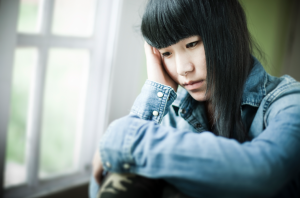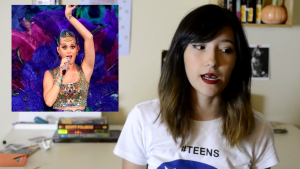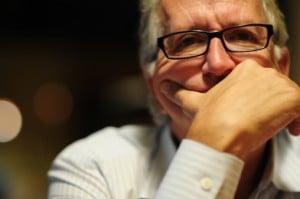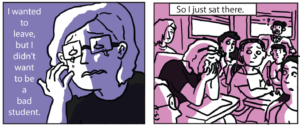“You don’t have an eating disorder.”
Many people who struggle with binge eating hear this phrase over and over again. They experience a denial of their disorder from friends, family members, and loved ones.
And this response can trigger a lot of emotions – from guilt and shame to insecurity and self-doubt – especially for someone already dealing with so much.
Unfortunately, that same denial resonates within some corners of the body-positivity and feminist movements.
There is a lot of misinformation about binge eating disorder (BED). I have heard individuals share their frustration with activist and feminist communities that shame them for their recovery process. For many, disordered eating is politicized in a way that erases their experiences and frames their disorder as a choice.
The misinformation and stigma of eating disorders within these activist spaces can give those struggling with BED the message “You don’t belong here.”
You have a body.
And sometimes, you may struggle to understand that body – how to nourish and live in that body in a way that works for you. But you are not at the opposite end of the body-positivity spectrum. You are right in there, trying to figure it out – like all of us.
And you deserve support.
So how can you rally behind the body acceptance movement, while also acknowledging and trying to recover from a binge eating disorder?
More specifically, how does one say “Hell yeah, eat what you want,” but also admit to struggling to eat in a way that’s sustainable and healthful for oneself?’’
Well, to start, here are four ways to begin to practice self-acceptance while also working to reconcile your binge eating disorder.
1. Tap Into What Binge Eating Is – And How It Applies to Your Experience
It seems like everyone has an opinion about binge eating disorder.
From body activists to food activists, people want to put their two cents in about who gets to have an eating disorder and what that eating disorder can look like.
And that’s bullshit.
The truth is that eating disorders are complicated.
Binge eating, like all eating disorders, are biopsychosocial in origin. Which means, they are influenced by 1) our bodies, 2) our brains, and 3) our environments.
For someone who isn’t struggling with an eating disorder (or who isn’t informed or trained to understand them) to invalidate your experiences is wrong.
Part of self-acceptance means acknowledging your lived experiences as valid and important. When our brains, bodies, and communities are giving us mixed (and contradictory) messages about what the “right” way to nourish our bodies is, it can be confusing to listen to our own internal voice.
That internal voice, no matter how quiet, exists for you. It’s the voice that tells you whether or not your current eating pattern feels like a choice or feels like a compulsion.
The Diagnostic and Statistical Manual for Mental Disorders (DSM-5) now identifies binge eating as a disorder, characterized by:
- Recurrent and persistent episodes of binge eating.
- Binge eating are associated with:
- Eating much more rapidly than normal
- Eating until feeling uncomfortably full
- Eating large amounts when not feeling physically hungry
- Eating alone because of being embarrassed by how much one is eating
- Feeling disgusted with oneself, depressed, or very guilty after overeating
- Marked distress regarding binge eating
- Absence of regular compensatory behaviors
The DSM-5 can be a good tool to understanding how the psychology community understands binge eating, but it may or may not fit into your own, individual experiences.
So listen to yourself and what feels sustainable for your body.
And if you’re struggling with mental health, the message of “Eat what you want, when you want!” may not work for you.
It’s a flaw in our movements that we assume that everyone is in a healthful position to choose to eat what they want, when they want it.
Struggling with binge eating means that you don’t always have that choice. Your eating is triggered by biological, psychological, and environmental factors that contribute to your eating past the point that you want to eat.
Acknowledging your eating pattern as a disorder is a practice of self-acceptance, allowing yourself to be a complicated, whole person.
2. Figure Out What ‘Healthy’ Feels Like for You
Just like there are contradictory messages about binge eating, there are contradictory messages about “health” in general.
The term “healthy” has been used to stigmatize and harass individuals and groups of people. And oftentimes, it’s grounded in assumptions and faulty science.
More often than not, discourse around health is rooted in the values and beliefs of the person promoting it.
I think it’s important for us to find healthy ways of eating and supporting our bodies. But I can’t tell you what that “healthy” eating looks like for you, your body, and your lifestyle – only you can do that.
What I do know is that we need to break away from a one-dimensional definition of health informed by flawed medical science.
Health is holistic. It involves nourishing your body and mind in ways that are sustainable, which differs person to person.
Sometimes going out to dinner with friends is just as healthy of a choice than a meal at home. Healthy means sometimes saying “no” to food and sometimes saying yes, and knowing why we make those choices and feeling comfortable with those choices.
Since many of us have been raised with messages about what is “healthy” and what is “unhealthy,” it can be difficult to tease apart what we feel actually is healthy eating for us.
A good way to start identifying what healthy looks like for you is by understanding what is currently motivating your eating habits, when does it feel satisfying for you, and when does it not feel satisfying.
Some things it may be helpful to pay attention to:
- How do you feel right before you eat? Emotionally, how are you feeling? What does your physiological response to hunger feel like?
- What kinds of food are you eating and how much? This is different than “How many calories are you eating?” A candy bar and a banana may have the same amount of calories; neither one is “good” or “bad,” but they nourish your body in different (and equally valid) ways.
- How do you feel after you eat? Emotionally, how are feeling? How does your body feel physically (hungry still? satisfied, but could eat more? full and bloated? a little sick?)
Tapping into these questions can help you identify some things that might be contributing to your eating.
It can also be helpful in identifying times when your eating behaviors leave you feeling satisfied and positive and when they may not. This can help you start to frame what “healthy” feels like for you, in your own body, in your own lifestyle.
A journal is a great, easy way to start to identify some of these things for yourself. For those with phones and apps, Recovery Record can be a helpful tool in tracking some of these patterns – but use whatever works for you!
Trying to adopt someone else’s way of practicing health is not sustainable.
Healthful living requires the knowledge of your body, mind, resources, wants, desires, and values that only you know.
3. Practice Body Acceptance While Working Towards Your Version of Healthful Eating
I am a feminist. I am an activist. I promote body-positivity. And like many feminists, activists, and body-positive supporters, I struggle accepting my body sometimes.
We all struggle in our own skin at some point in our lives – some times more than others.
If you are experiencing mental health issues that make it difficult to eat and nourish your body in ways that feel right for you, you may or may not also struggle with your body image and body acceptance.
Regardless, body acceptance can be hard to embrace when it seems like everyone – from strangers and acquaintances to our friends, family members, and fellow activists – wants to tell you how you should feel about your body.
Some individuals may try to tell you that your eating behaviors and your body are two separate things. Or that your mental health and your body are two separate things. Those people are wrong.
The biopsychosocial model of eating disorders is not uni-directional. Your biology, mind, and environment influence your eating behaviors, yes. But also, your eating behaviors influence your biology, mind, and environment. So it makes sense that when you are feeling out of balance, your body might feel out of balance, too.
In those moments, body positivity may not be looking in the mirror and saying “I look awesome!”
Body positivity can be experiencing yourself in your body, acknowledging all that your body enables you to do, and accepting it for what it is today, right now, without shame or anxiety.
Here are tips for how to practice body acceptance, while also working through your eating disorder:
1. Reduce or remove judgmental language related to your eating behaviors and body.
You are in the process of trying to understand yourself and your body better. This process is not about being “good” or “bad.” It’s about understanding how you want to nourish your body and developing strategies to help yourself do that more regularly.
Similarly, your body is never “good” or “bad.”
Tap into what bodily sensations are happening for you and your own emotions, but avoid language or judgments about those sensations or emotions.
2. Talk about your body (both to yourself and others) in ways that promote body acceptance, while also acknowledging your experiences.
You don’t need to adopt the language and words that work for someone else. Find the language to speak back to judgmental thoughts or communicate how you feel in your body that represents you.
That may not be “I love everything about my body.” It may mean “I accept my body.” It may mean focusing on specific actions rather than feelings, like “My body allows me to feed and pet my animal,” or “My body allows me to hold the hand of someone I care about.”
Body positivity can be experienced in a variety of ways. Find statements that help you feel safe and empowered in your own skin.
And it’s also okay to share “I am struggling in my body acceptance today.” The important thing is to try to separate the struggle from your body – the struggle occurs when we are judging our body and/or bodily sensations. The struggle isn’t our body itself.
3. Focus on what your body does and how your body feels. Discover times when you feel comfortable in your own body.
How does your body feel when taking a warm shower or bath? How do your hands feel holding a warm cup of coffee? How does your belly feel when you are breathing slow, calm breaths?
How do you use your body throughout your day and how does your body feel in those moments? Does it feel strong? Does it feel warm? Does it feel tense or relaxed? How do you feel, emotionally, in those moments?
We have a tendency to ignore our body or selectively focus on only certain parts of our body. Tap into it throughout the day, in moments that we may normally be taking advantage of our body and what it does.
4. Start to develop a sense of body image flexibility.
Dr. Emily Sandoz writes about body flexibility in her book Living with Your Body and Other Things You Hate: Let Go of Your Struggle with Body Image Using Acceptance and Commitment Therapy.
Body image inflexibility shows up when we start to develop rules and stipulations for what we can and cannot do specific to our body image fluctuation (like “I do not like x part of my body, so I can’t wear certain clothes” or “I am bloated, so I can’t have sex”).
Flexibility, on the other hand, involves experimenting and seeing if you can experience your body a certain way while also still acting in ways that are congruent with your goals, desires, and values.
4. You Are Not Alone
Already many individuals suffering from binge eating feel like they are alone. It can be a secretive and stigmatized disorder. Activists may feel even more alone or isolated given unfair (or assumed) expectations within their own communities.
The truth is, many body-positive activists also work to reconcile their body positivity with binge eating.
Although their experiences may look different from your own, it can be helpful to explore and understand how other activists have navigated similar issues.
Amber Sarah is a body-positive activist and blogger who regularly writes about unrealistic body standards and empowerment.
In her blog, “Andipose Activist,” she also shared about her experiences with binge eating. She writes:
“I began to surround myself with people who had bodies who looked like mine. I saw that they were happy. They were loved. They liked their bodies. They didn’t let anything hold them back. If it was possible for them, could it be possible for me, too? It took a lot of work and a lot of soul searching, but slowly I started to stop hating myself so much.”
Find others, either in real life or through online communities, that support you. Find others that understand both your activism and your eating disorder, and support the ways in which you make sense of those two aspects of your identity.
Additionally, it isn’t your job to teach others about binge eating and how it fits into the body-positivity movement.
Sharing your experiences, if it’s something that is valuable and important to you, can help make feminist and activists space more inclusive.
***
Awesome body activist and Everyday Feminism editor and writer Melissa A. Fabello wrote it best when she said, “One of the basic tenets of what we believe here at Everyday Feminism is that your truth matters and that your story needs to be told.”
The feminist and body-positivity movements should rooted in understanding our diverse experiences and giving voice and space for those experiences. You should not feel like you have to hide pieces of yourself in order to feel supported in these communities.
You are not a body positive activist despite your eating disorder. You are, in fact, at the heart of these communities.
For more information, check out the following sites/articles:
- National Eating Disorders Association
- Andipose Activist: One fat girl’s battle against size discrimination
- “Binge Eating in Men” by Dr. Carolyn Ross
- “Six Ways to Reconcile Your Eating Disorder with Your Feminism” by Melissa A. Fabello
[do_widget id=”text-101″]
Aliya Khan is a Contributing Writer for Everyday Feminism and identifies as a feminist, activist, and life-long learner. She provided crisis support to survivors of abuse at the Women’s Center and Shelter of Greater Pittsburgh and is currently living, studying, and writing in the Pacific Northwest.
Search our 3000+ articles!
Read our articles about:
Our online racial justice training
Used by hundreds of universities, non-profits, and businesses.
Click to learn more





















